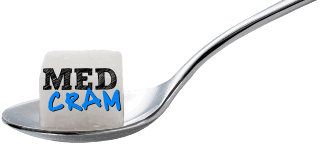In this video, Dr. Seheult of MedCram discusses a common ICU trap that can occur when using vasopressors in certain scenarios. This vasopressor trap is one of the most dangerous traps in the ICU and it is important for critical care physicians to recognize this. What is an ICU vasopressor trap? How do you get into it? And most importantly, how do you get out of it?
What is the circulatory system’s role?
It’s important to understand the layout of the circulatory system. You have a heart which pumps out blood through the arteries to target organs such as the brain, liver, and kidney. If these organs don’t get enough blood, which carries oxygen, to them then these organs will switch over to anaerobic metabolism and create lactic acid. In the body, there are alpha 1 and beta 2 receptors in the smaller arteries. There are medications called vasopressors which will cause constriction and activate alpha 1 receptors. When these receptors cause vasoconstriction, they are make the blood pressure increase.
What do vasopressors do?
For example, in a patient with sepsis, many times the smaller arterioles are dilated and as a result the blood pressure in the end target organ is decreased. Using vasopressors will cause the smaller arteries to constrict and increase the pressure.
How does ejection fraction affect things?
Sometimes patients are coming in with cardiovascular or cardiogenic shock. The heart has an ejection fraction (EF), that is how much blood it can pump. A normal ejection fraction is 50-60%. In CHF patients, the EF can be as low as 10-20%. In patients such as this, when they come in they may have a low blood pressure and it might be assumed that this is due to septic shock but it may in fact be due to the fact that the heart is not pumping well. Now it could be a combination of both septic shock and cardiogenic shock also if the EF is low. As we continue to use vasopressors to help with the blood pressure, this is where we start to get into the vasopressor trap. As you continue to constrict the alpha 1 receptors, it may improve the bp in the short run; however, due to the fact that the heart can’t effectively pump enough blood, the amount of blood that is actually getting to the target organs is severely impaired and as a result of this will cause a lactic acidosis. This results in a lower pH in the body which results in the heart having a more difficult time pumping and it ends up inactivating some of the alpha 1 receptors. What often happens next is that you will start off with a vasopressor such as norepinephrine and “max” this out and then add another vasopressor such as epinephrine. But this constricts limited blood flow to organs further causing more lactic acidosis and the cycle worsens and repeats itself until a vicious cycle has been created.
What medication could change the outcome?
Dr. Seheult reports he has several occurrences where patients end up “maxed” out on at least 3 vasopressors and are still poorly responding. This should give the practitioner pause for thought and consider that they may be caught in the vasopressor trap. If you had known that the ejection fraction was low to begin with then you might have added a different vasopressor to begin with to help with that. On the heart are Beta 1 receptors and in the vasculature are Beta 2. If you add a vasopressor that activates the Beta 1 and Beta 2 receptors then you would increase the ejection fraction which would naturally increase the blood flow coming from the heart and subsequently increase the blood pressure. You would be able to open up the smaller arteries leading to the target organs allowing more blood flow towards them and reducing the amount of lactic acid being produced.
A medication such as dobutamine can be your ticket out of the vasopressor trap. Dr. Seheult discusses a case he had where he determined by bedside ultrasound that the ejection fraction was low, started dobutamine and then slowly started to remove the other vasopressors such as phenylephrine, epinephrine or norepinephrine which started to allow increased perfusion.
If we had continued in the original situation, the most likely result would be that the lactic acid would continue to go up and result in a lower and lower pH until the patient coded.
It is important to figure out what the heart function is. There are ultrasound courses that can be taken to help with this. MedCram offers ultrasound courses as well as a course in vasopressors explained clearly.
